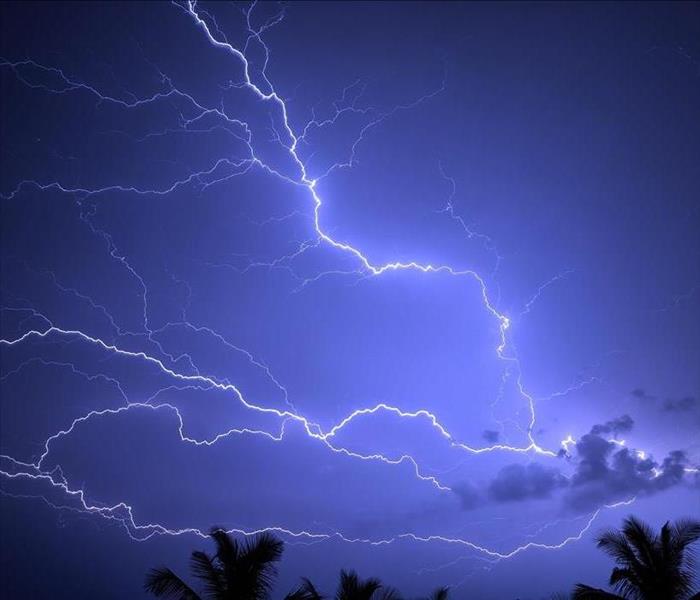Storm Safety: Lightning 101
9/23/2022 (Permalink)
 An important part of storm safety is understanding different types of lightning that you may see in a thunderstorm.
An important part of storm safety is understanding different types of lightning that you may see in a thunderstorm.
With almost any storm event, lightning is a serious human safety concern, but it also poses risks to residential and commercial properties. Even hurricanes sometimes produce lightning near the eye of the storm. An important part of storm safety is understanding different types of lightning that you may see in a thunderstorm. In today’s blog, informed by NOAA’s “Lightning Types” article, we’ll describe 3 different kinds of lightning and the property safety risks associated with them so that you can best protect yourself, as well as your home or business.
Cloud-to-Ground Lightning
The type of lightning with which the majority of people are familiar is cloud-to-ground lighting, which means that a channel of negative charge descends from a storm cloud and is met with a positive charge from tall objects nearby, which can include trees and power lines but- most important with regards to our topic today- tall structures like homes, office buildings, and other commercial buildings as well. The unification of the negative and positive charges causes an electrical current to flow. If the catalyst of the positive charge is a home or commercial property, the electrical current generated can pose safety risks to the property and people inside of it, as it can impact the electrical system and ignite fires. One way to prevent extensive damage from a lightning strike is equipping your property with surge protectors. Additionally, if you know that there is lightning in the area, stay away from electrical appliances and refrain from activities involving water, like taking a shower or washing dishes.
Cloud Flashes
Sometimes, lightning does not reach the ground. Cloud flashes describe lightning that usually remains in the clouds through what NOAA calls “intra-cloud lightning flashes.” This type of lightning is caused by “an electrical discharge between oppositely charged areas within the thunderstorm cloud,” according to The National Weather Service. While cloud-to-ground lightning may be the most dangerous type of lightning, if you see cloud flashes, a safety risk is still present. Cloud flashes still indicate that the storm is producing lightning, which means that there is risk of cloud-to-ground lightning developing.
Heat Lightning
You are probably familiar with the term “heat lightning,” but there is actually no such thing as heat lightning. According to The National Weather Service, if you see cloud flashes without thunder, what you are seeing is faint lightning flashes from a thunderstorm far enough away that you can’t hear the thunder or see the cloud-to-ground lightning generated by it.
Experience Lightning Damage? Call SERVPRO
If your residential or commercial business experiences lightning damage during a storm, call SERVPRO Team Wall. Our professional, experienced storm damage restoration specialists are equipped with the tools that will help make your property’s lighting damage “like it never even happened” after a storm. Call SERVPRO of Hunt Valley and Harford County at (410) 229-0012 to get in touch with one of our team members or visit our website to learn more about our Storm Damage Restoration capabilities, such as storm restoration services tailored specifically to commercial properties, our Disaster Recovery Team for large losses, and our water restoration process. To find peace of mind after any storm emergency and restore your property to its preloss condition, call SERVPRO Team Wall today.





 24/7 Emergency Service
24/7 Emergency Service